I once had a client say, “I’ve emailed twice and still don’t know who’s handling my issue.”
That was the moment I realized our process was broken. I knew we couldn’t scale on scattered inboxes anymore, so I opted for a ticketing system. It instantly solved the chaos by converting every request into an organized, trackable ticket.
The result was accountability, faster responses, and customers who finally felt heard. From my own experience, the right ticketing system doesn’t just improve support, it transforms how a business runs.
In this guide, I’ll cover what a ticketing system is, its benefits, and how to choose one wisely.
What Is a Ticketing System?
A ticketing system is a software that helps businesses organize, track, and resolve customer or employee requests from a single platform. Instead of relying on scattered emails or messages, each request becomes a “ticket” that can be assigned, prioritized, and closed efficiently.
If you’ve ever wondered, ‘what is a help desk ticketing system?’ think of it as the central hub that powers modern customer support and internal service management.
Here’s what makes a ticketing system so effective:
- Converts emails, chats, or calls into trackable tickets
- Centralizes all requests in one dashboard
- Assigns issues to the right person or team
- Tracks status, priority, and deadlines for accountability
- Improves customer satisfaction with faster, more transparent resolutions
Why Businesses Need a Ticketing System
From automation to smarter collaboration, a customer service ticketing system offers features that directly enhance user experience. Let’s look at the most impactful benefits:
1. Easily Track the Entire Ticket Lifecycle
Without structure, requests often vanish in messy inboxes. A ticketing management system ensures every issue is logged, tracked, and resolved systematically. From the moment a ticket is created until it’s closed, you have full visibility into its progress.
With status updates, priorities, and ownership clearly defined, teams work more efficiently and customers always know where things stand.
2. Capture Tickets From Multiple Channels
Customers can contact your support team through email, chat, forms, calls, and chatbots. Without a unified system, these queries get scattered. A ticketing system brings all these conversations into one dashboard, giving your team full context.
Also, a ticketing system with AI chatbots can suggest FAQs, auto-create tickets, and route them by priority, ensuring no request slips through the cracks.
3. Keep Your Inbox Organized
A ticketing system helps you prioritize urgent issues, filter requests, and assign tickets to the right people instantly.
Features like labels, internal notes, and attachments allow teams to collaborate directly inside tickets. This not only keeps communication transparent but also ensures every request gets resolved without confusion or duplication.
4. Automate Customer Support
Manual support can feel slow and overwhelming. With automation, you can auto-assign tickets to the right agents, use canned responses for instant replies, and rely on AI help desk for accurate suggestions.
Plus, you can also deploy chatbots to deflect FAQs, send real-time notifications, and use AI summarization to capture customer intent—so you resolve issues faster and delight customers.
5. Real-Time Reports & Dashboards
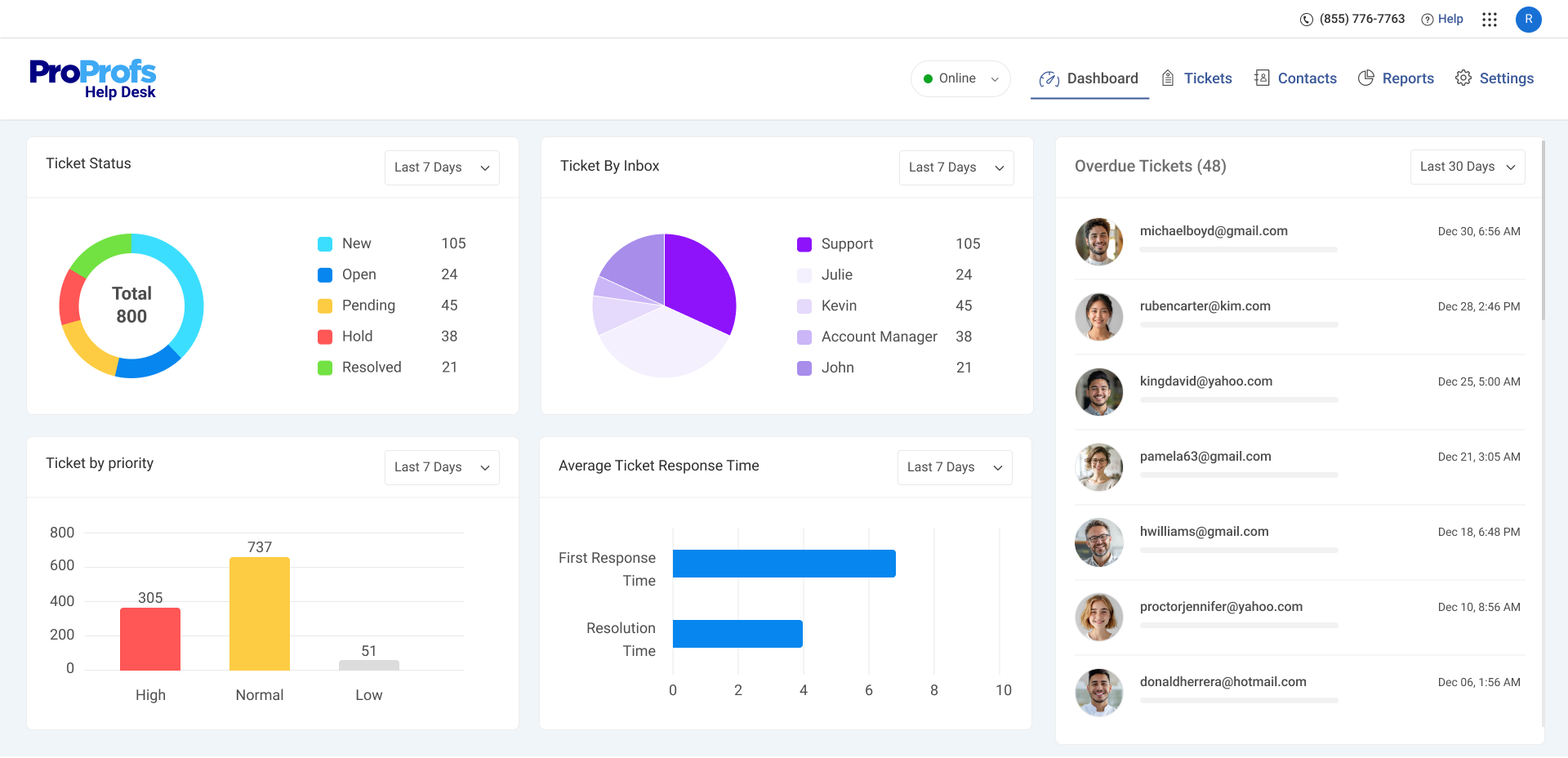
Support performance is only as good as the insights behind it. Ticketing systems offer real-time dashboards to monitor response times, resolution rates, and SLA compliance.
Managers can generate reports, track agent performance, and even share CSAT surveys for instant customer feedback. These insights turn raw data into action, helping businesses continually optimize service quality.
How Does a Ticketing System Work?
Let me walk you through how a support ticketing system works in practice. For clarity, I’ll use ProProfs Help Desk as an example to illustrate the process.
Step 1: User Submits a Request
A user encounters an issue and submits a support request, either through a customer service portal, email ticketing system, live chat, form, or by calling the IT department.
The request can include information such as the user’s name, contact information, and a description of the problem.
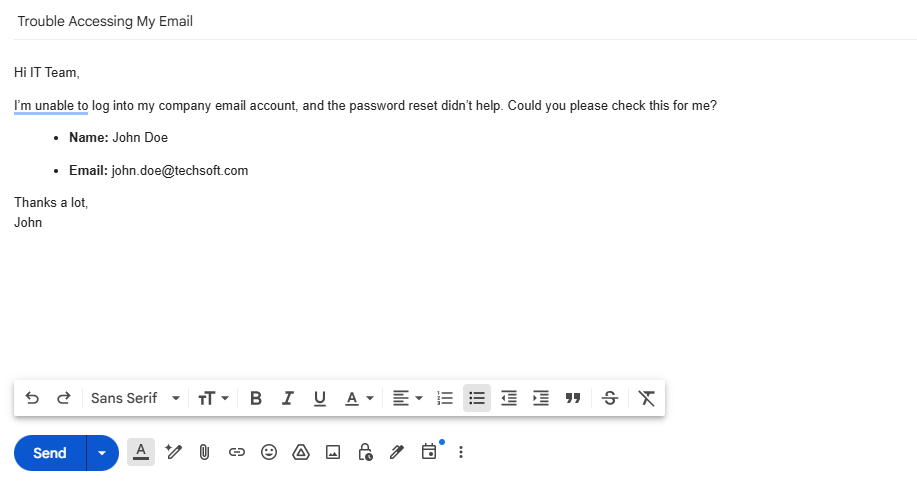
Example: John, an employee, encounters an issue with his company email account. He uses his personal email ID to submit a support request detailing the problem he’s experiencing, providing his name, email address, and a description of the issue.
Step 2: New Ticket Creation
The ticketing system automatically creates a new ticket, assigns it a unique number, and categorizes it based on the type of issue reported.

Example: The IT ticketing system automatically generates a new ticket for John’s email problem. The system assigns a unique ticket number to the request and categorizes it as ‘Bug.’
Step 3: Ticket Assignment to IT Staff
Once created, the ticket is then automatically assigned to an appropriate agent based on their availability or skill sets. The agent receives an email notification of the new ticket.

Example: The ticket is then automatically assigned to Naomi, a member of the IT support team known for her expertise in email systems. She gets a notification and can quickly start working on it.
Step 4: Communication & Resolution
At this stage, the agent works on finding the right solution to resolve the issue. They may also reach out to the user to gather more details or share timely updates.
Example: Naomi checks John’s email issue and quickly understands the concern with the help of the AI ticket summarization feature of ProProfs Help Desk. AI also suggests three automated responses that she can use right away for a speedy resolution.
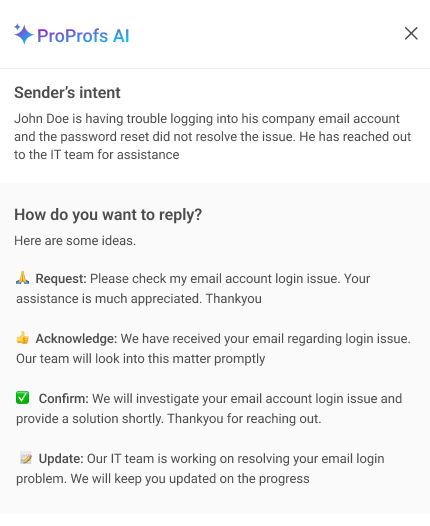
But Naomi feels she needs more details to understand the root cause of the issue. She prompts AI to draft an email response asking the user for: error message, browser in use, etc.
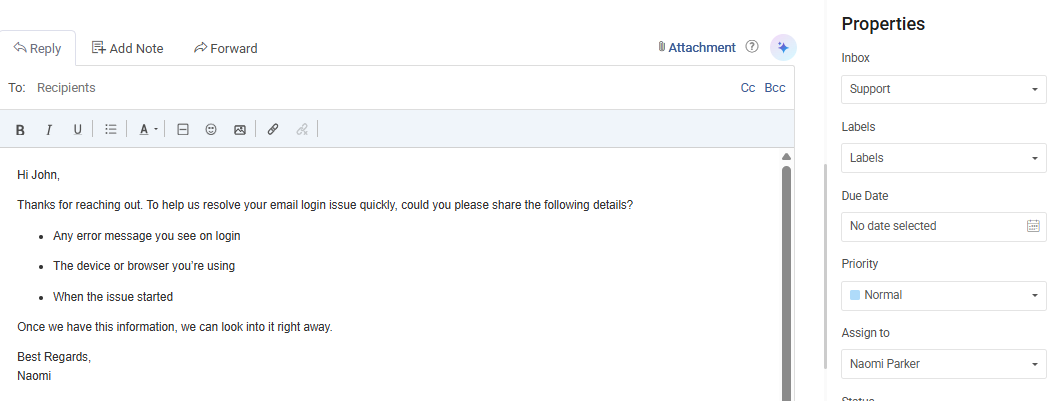
Step 5: Ticket Closure
After addressing the issue, the IT staff member marks the ticket as Resolved, and the user receives a notification.
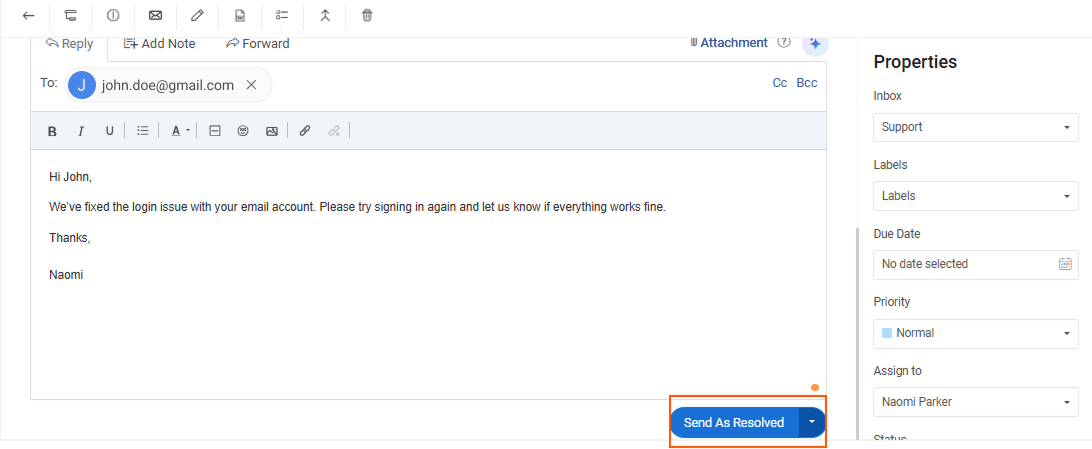
Example: After the necessary investigation and successful resolution of John’s email problem, Naomi marks the ticket as Resolved within the ticketing system. John receives a notification informing him that his issue has been resolved and that the ticket is now closed.
Step 6: End-User Feedback
But that’s not the end. A survey is automatically shared with the user that asks them to rate their service experience. You can use this feedback to gauge agent performance and measure user satisfaction.

Example: Once John’s issue is fixed, he gets an automated help desk survey to rate his IT support experience on a scale of 1-5. His feedback helps the company measure satisfaction and track Naomi’s performance.
Key Ticketing System Features That Drive Better Support
A ticketing system organizes scattered requests into trackable tickets, ensuring speed, accountability, and smoother resolutions. Some key features it offers include:
1. Automated Ticket Assignments
Instead of manually sorting through requests, automated ticket assignments ensure every inquiry is instantly routed to the right person or team. This prevents delays, balances workloads, and matches each issue with the most qualified staff, ensuring faster resolutions and improved efficiency for both employees and customers.
2. Canned Responses for Faster Replies
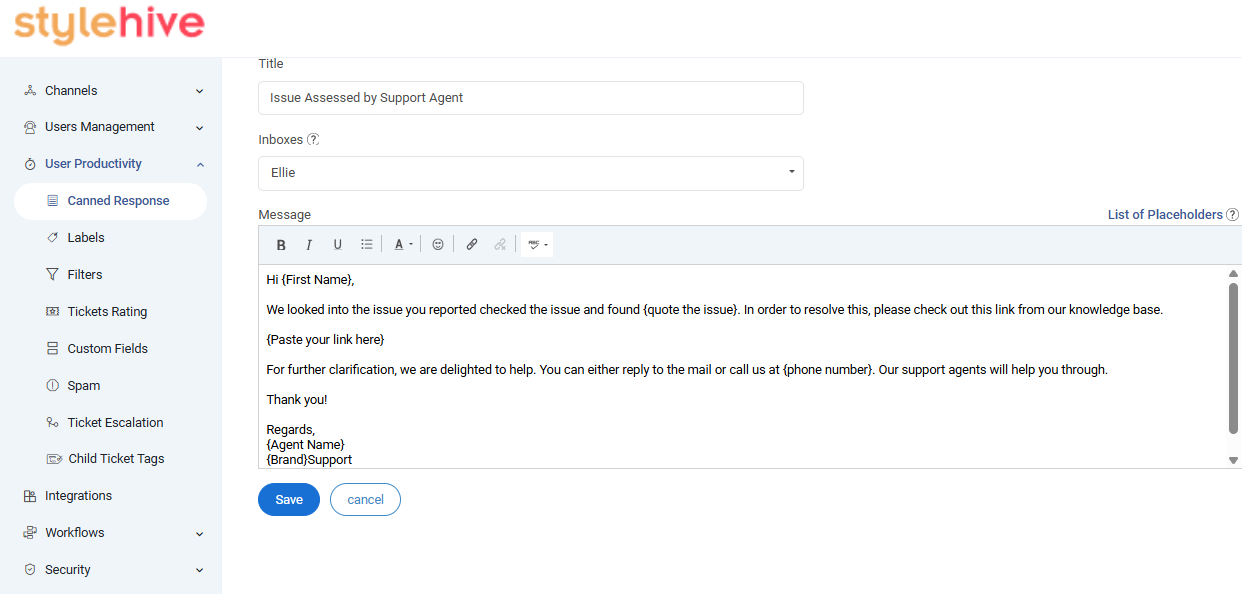
Many customer questions are repeated, such as password resets or policy clarifications. Canned responses allow teams to reply quickly with pre-written templates that can be customized when needed.
This saves valuable time, ensures consistency in communication, and allows agents to focus on complex issues that require personal attention.
3. Ticket Prioritization & Escalation
Not every ticket carries the same urgency. Prioritization enables critical issues — like service outages or payroll errors — to be addressed immediately, while routine queries are managed systematically.
Escalation rules ensure unresolved tickets automatically move to higher-level staff, helping teams meet SLAs and avoid missed deadlines that impact business trust.
4. Parent-Child Ticketing for Complex Issues

Some problems are multi-layered and require input from several departments. Parent-child ticketing breaks a single major issue into smaller, connected sub-tickets.
This approach keeps progress visible, ensures accountability across teams, and guarantees that all dependencies are resolved before the main issue is closed, resulting in comprehensive problem resolution.
5. Shared Inbox
The shared inbox centralizes all customer-facing email accounts—like support@, sales@, and info@—into one unified dashboard. It allows teams to collaborate effortlessly through ticket assignments, internal notes, and status tracking.
6. Internal Notes for Team Collaboration
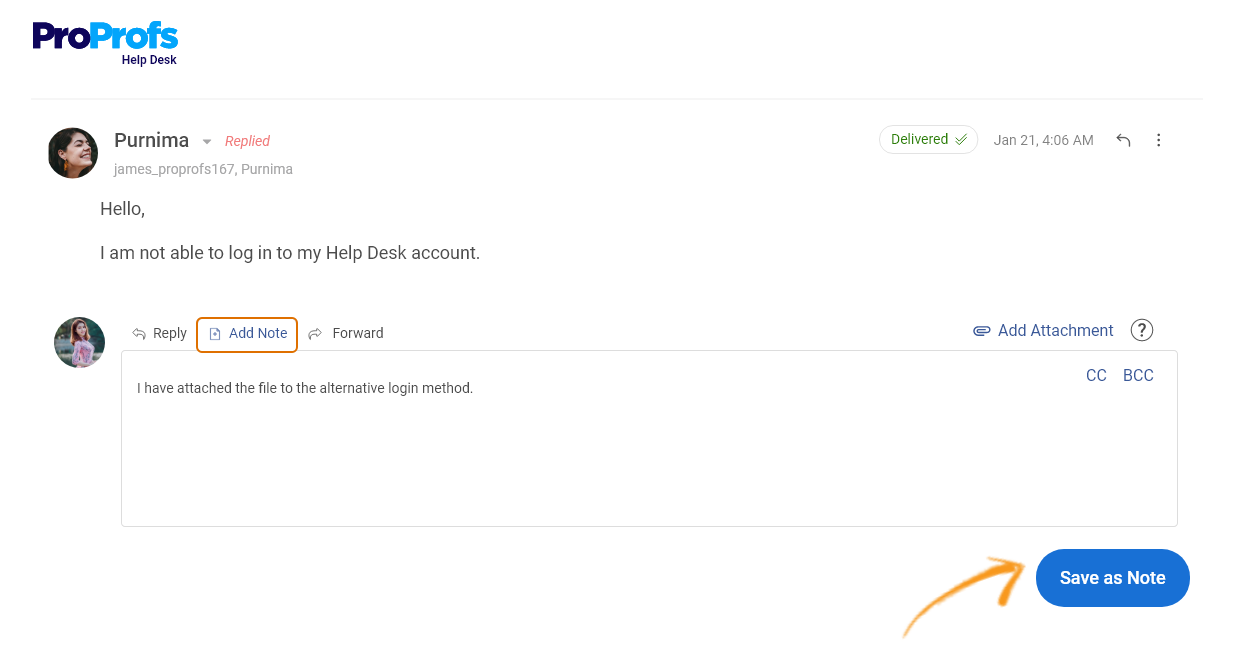
Many tickets require collaboration, but customers don’t need to see internal conversations. Internal notes allow agents to share updates, flag challenges, and provide context for teammates directly within the ticket. This private communication improves teamwork, prevents missteps, and ensures everyone has the information needed to resolve issues efficiently.
FREE. All Features. FOREVER!
Try our Forever FREE account with all premium features!
Ticketing System Selection Checklist: Get It Right the First Time
With so many tools out there, the right ticket system should fit your workflows, scale with growth, and keep data secure. Use this checklist to stay focused on what matters most:
| Selection Criteria | Why It Matters |
|---|---|
| Ease of Use | Simple, intuitive tools boost adoption and reduce training time. |
| Automation & Workflows | Automates routing, prioritization, escalation, and responses to save time. |
| Multi-Channel Support | Combines email, chat, phone, and social requests in one dashboard. |
| Reporting & Analytics | Tracks SLAs, resolution times, and performance with real-time reports. |
| Customization & Flexibility | Custom forms, labels, and dashboards adapt to your workflows. |
| Data Security & Compliance | Protects sensitive data with encryption, SSO, IP limits, and GDPR/HIPAA compliance. |
Streamline Support Operations With the Best Ticketing System
A customer service ticketing system helps businesses bring order to scattered requests, ensuring accountability, faster responses, and better customer experiences. It transforms support from chaotic inbox management into a structured, scalable process.
When choosing a system, focus on simplicity, automation, multi-channel capture, and strong data security. Start with what matters most today, but make sure the platform can grow with your business tomorrow.
Personally, I recommend ProProfs Help Desk — I’ve seen how it simplifies ticket management, automates workflows, and keeps everything organized with real-time dashboards. It’s a tool designed to help teams support smarter, not harder.
Frequently Asked Questions
How does a ticketing system help with reporting?
It simplifies reporting with real-time dashboards, ticket history, and agent performance reports, giving teams insights into response times, resolution rates, and customer satisfaction.
Can ticketing systems integrate with Shopify, WhatsApp, or Slack?
Yes. With omnichannel support, tickets can flow from Shopify, WhatsApp, Slack, email, or chat into one dashboard for easier management.
How do ticketing systems help in reducing duplicate tickets?
Ticketing systems prevent overlaps with shared inboxes, agent collision detection, and ticket merging, ensuring teams don’t waste time on the same request.
FREE. All Features. FOREVER!
Try our Forever FREE account with all premium features!

 We'd love your feedback!
We'd love your feedback! Thanks for your feedback!
Thanks for your feedback!






